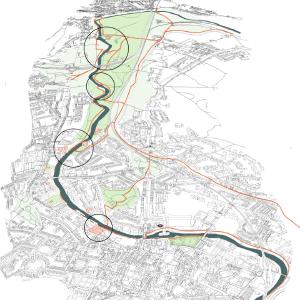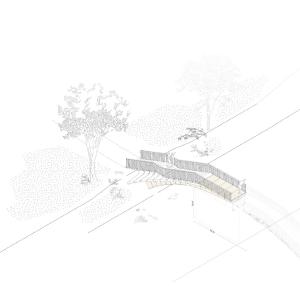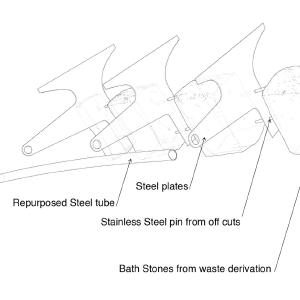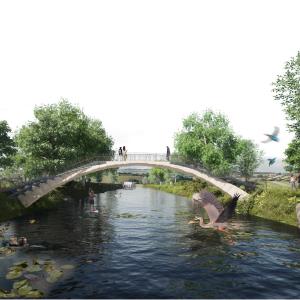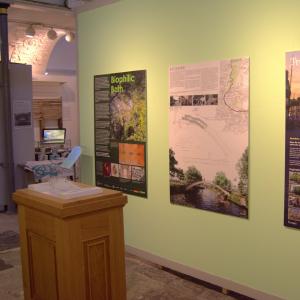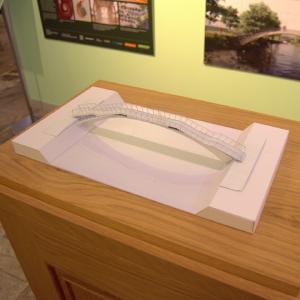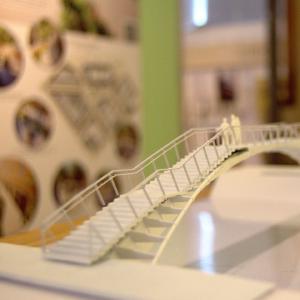Client: Museum of Bath ArchitectureEngineer: Format EngineersLocation: Bath, United Kingdom
Date: 2024-07-11 00:00:00 +0000 UTCTags: Steel, stone, bridge, Digital Design, Parametric Design, low carbon
Stitching bridge
Our winning entry for the Biophilic Bath competition proposed a number of new bridge links across Bath, more easily joining areas of natural beauty and reanimating neglected urban spaces. The bridges are a hybrid of waste stone and recycled steel, a combination which would be lower in in cost but critically, lower in embodied energy compared to a conventional bridge structure.
Bath has an historic connection to water, it is an elemental part of the geography of the city, Water is inherent in its name, part of its DNA and one of its most valuable assets. It makes the city a World Heritage city, one which is known around the world for the healing quality of its natural streams and for the architecture of its buildings. However, we contend that it’s rivers are an underexploited conduit to further reconciling its history to its future.
The hot underground streams of the city are celebrated but the River Avon, the main body of water physically dividing the city, is in many places disregarded. Rare is the direct access to the river within the city, rare are the calming public places with views onto the waterway. The river banks are poorly appreciated and are often unwelcoming to the public. The river sides can be a faded witness to a once productive industrial site. Most recently, a proposal for the development of a Lidl supermarket in a prime location where access could have been given to the public to the river, has been a contentious issue. Some feel this may highlight the lack of appreciation by the city for its river and its potential for future growth and wellbeing . In many cities, easy river links with rewarding views and facilities for physical engagement have been proven to be beneficial to the wellbeing of their inhabitants and help the rewilding of urban areas. Rivers are streams of opportunities to develop sustainable cities. They are vital to reduce temperatures in hot summers, they are home to many plants and animals. Our concept is the creation of a new river walk stitching together existing private and public footpaths. The proposal also provides for new tangible and practical additions, including new footbridges and walkways to ease and promote pedestrian access to and from the city centre. The river walk would be a natural link between two rural lungs:
- The natural lung of Bathampton Meadows,
- The urban, reclaimed lung, at the Cattle Market, near Walcot Street
These nodes are two of the four potential sites identified as ideal locations for river crossings. They allow the public to better engage with their surroundings, to breathe, to become one with landscape and becoming energised by nature. The new walk along the river would give access to many other green spaces, wetlands, and be a positive addition to the existing network of natural and wild spaces around and in the city.
Each site would balance each other by being as equally important in the development of a biophilic city. The wild meadows in Bathampton encourage wildlife and biodiversity and by integrating this site as part of a loop directly linked to the city centre this site could be a destination for all to observe nature. Our proposal includes a new urban reclamation yard on the Cattle Market site in Walcot Street. This would be located a few streets away from a similar, and much missed facility. This could be an opportunity to create a material storage park where trees are replaced by stacks of timber boards, the romantic idyll of an undulating landscape mimicked by a curated assembly of stones, becoming a place of potential for individuals and business. Half way between a public park and an organised reclamation yard it would be a place to meet and exchange, a place for magic to happen. We would like to develop this proposal with minimal intervention using as much as possible the existing infrastructure, topology and local materials. When new construction will be required it will be developed according to the principles of re-use and circular economy and design. We would collaborate with regional industries such as the Bath Stone Company to use only materials that would be diverted from landfill or re-used post deconstruction.
Piers for the riverwalk pathways could be developed using old hardwood structures or surplus steel pontoons. The crossings would be contemporary arch stone bridges, using waste stones quarried many years ago but then ignored as surplus material. These would be adapted to suit the site, giving a substantial but natural solidity to new structures. A subtle repurposed steel deck could be added to provide lateral stiffness to the design keeping the proposal lightweight and durable. With this proposal we would like to showcase creative design using local materials and construction waste. These subjects are intrinsic to the challenges we are facing in the time of global warming but they are also avenues for solutions and creativity. Proposing a debate around the future of a reclamation yard in the heart of an heritage city like Bath as much as promoting relaxed transport and supporting access to natural spaces is what animates us with this provocative, idealistic, romantic riverwalk proposal.
Our proposal is on public display 10th July to September 2024 at the Museum of Bath Architecture.
